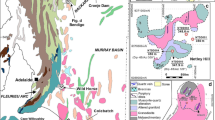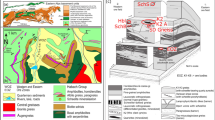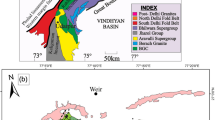Abstract
Andesites near Brestovačka Banja belong to the Late Cretaceous Timok Magmatic Complex (TMC), which hosts the world-class Bor metallogenic zone including numerous porphyry-copper and epithermal deposits. Two main volcanic phases are recognized in the TMC. The newly discovered Mn mineralization reported here is associated with the second volcanic phase of Turonian-Campanian age. Manganese mineralization containing 58 % MnO on average, occurs as black veins, lumps and nests filling cracks and cavities within an autoclastic andesite, which was deposited in a subaqueous environment. This rock also contains minor Fe mineralization, which is contemporaneous with the manganese mineralization. Manganese mineralization predominantly consists of Mn-Ca silicates (macfallite, pumpellyite-Mn, orientite, bustamite) and Mn oxides (pyrolusite, manganite). Micrometer-scale mineral intergrowths and locally preserved botryoidal and colloform textures are characteristic features of this uncommon mineral assemblage. The features could indicate that the mineralization was formed by deposition from a primary colloidal assemblage and is of sub-marine hydrothermal origin. Orientite is the only Mn mineral with grain size reaching several tenths of micrometers and showing prismatic crystal habit. Scarce to rare associated minerals are hollandite, crednerite, an unknown REE mineral, powellite, pyrite, barite and galena, in decreasing abundance. Trace element analyses of the Mn mineralization show different element contents and REE patterns compared to those of the volcanic host-rock. Manganese mineralization shows relatively high contents of Cu – 1784 ppm, Mo – 20 ppm and As – 268 ppm. These elements are commonly enriched in the Cu deposits of the Bor zone and their relatively high contents in the studied Mn crusts indicate sea-floor hydrothermal vents as a source of the metals.









Similar content being viewed by others
References
Banješević M (1999) Upper cretaceous volcanic facies of the Bor zone (eastern Serbia). University of Belgrade, Faculty of Mining and Geology, Serbia, MSc thesis
Banješević M, Cvetković V, Von Quadt A, Peytcheva I, Cocić S (2006) Geodynamic reconstructions based on the magmatism in the Timok Magmatic Complex (East Serbia) – part of the Carpathian–Balkan Belt. 18th Congress of Carpathian-Balkan Geological Association, 27–29, Belgrade, Serbia
Banješević M (2006) Upper cretaceous magmatism of the timok magmatic complex (eastern Serbia). Dissertation, University of Belgrade, Faculty of Mining and Geology, Serbia
Banješević M (2010) Upper cretaceous magmatic suites of the timok magmatic complex. Annales Geologiques da la Peninsule Balkanique 71:13–22
Basso R, Lucchetti G, Palenzona A (1989) Orientite and macfallite: new occurrence at the cerchiara mine (eastern Liguria, Italy). Neues Jahrb Mineral Monatsh 455-460
Berza T, Constantinescu E, Serban-Nicolae V (1998) Upper cretaceous magmatic series and associated mineralisation in the carpathian-Balkan orogen. Resour Geol 48:291–306
Sclar CB (1961) Optical crystallography of orientite from oriente province, Cuba. Am Mineral 46:226–232
Ciobanu CL, Cook NJ, Stein H (2002) Regional setting and geochronology of the late cretaceous banatitic magmatic and metallogenetic belt. Mineral Deposita 37:541–567
Clark HA, Ullrich DT (2004) 40Ar/39Ar age data for andesitic magmatism and hydrothermal activity in the timok massif, eastern Serbia: implications for metallogenetic relationships in the Bor copper-gold subprovince. Mineral Deposita 39:256–262
Cocić S, Koželj D, Banješević M, Krstić S (2002) Potential of the Čoka Kupjatra area in epitermal gold mineralization – new review. 34th International Octobar Conference, J Mining Metall - Special issue, Bor, Serbia, 80–86
Cvetković V, Šarić K, Prelević D, Genser J, Neubauer F, Höck V, von Quadt A (2013) An anorogenic pulse in a typical orogenic setting: the geochemical and geochronological record in the east Serbian latest cretaceous to palaeocene alkaline rocks. Lithos 180–181:181–199
Dekov VM, Savelli C (2004) Hydrothermal activity in the SE tyrrhenian sea: an overview of 30 years of research. Mar Geol 204:161–185
Dimitrov C, Kostov I (1954) On the origin of the manganese ore deposits in the srednogorie zone. Ann Univ Sofia Fac Biol Géol Géog 48(2):23–60(in Bulgarian)
Đorđević M, Banješević M (1997) Geology of northern part of the Timok Magmatic Complex. Booklet and geological map 1:50 000. Federal Ministry of Economics, 171, Beograd (in Serbian)
Einaudi MT, Hedenquist J, Inan EE (2003) Sulfidation state of fluids in active and extinct hydrothermal systems: transitions from porphyry to epithermal environments. in S.F. Simmons SF, graham I (eds) volcanic, geothermal, and ore-forming fluids: rulers and witnesses of processes within the earth. Soc Econ Geol Spec Publ 10:285–313
Fisher R, Schmincke HU (1984) Pyroclastic rocks. Springer, Berlin
Fan D, Yang P (1999) Introduction to and classification of manganese deposits of China. Ore Geol Revi 15:1–13
Janković S (1990) Types of copper deposits related to volcanic environment in the Bor district, Yugoslavia. Geol Rundsch 79:467–478
Lips A, Herrington R, Stein G, Koželj D, Popov K, Wijbrans J (2004) Refined timing of porphyry copper formation in the Serbian and bulgarian portions of the cretaceous carpatho–Balkan belt. Econ Geol 99:601–609
Ljubović-Obradović D, Carevac I, Mirković M, Protić N (2011) Upper cretaceous volcanoclastic-sedimentary formations in the timok eruptive area (eastern Serbia): new biostratigraphic data from planktonic foraminifera. Geol Carphat 62:435–446
Karamata S, Knežević V, Pécskay Z, Djordjević M (1997) Magmatism and metallogeny of the ridanj–krepoljin belt (eastern Serbia) and their correlation with northern and eastern analogues. Mineral Deposita 32:452–458
Karsli O, Chen B, Aydin F, Sen C (2007) Geochemical and Sr–Nd–Pb isotopic compositions of the eocene dolek and saricicek plutons, eastern Turkey: implications for magma interaction in the genesis of high-K calc-alkaline granitoids in a post-collision extensional setting. Lithos 98:67–96
Kolb M, von Quadt A, Peytcheva I, Heinrich CA, Fowler SJ, Cvetkovic V (2013) Adakite-like and normal arc magmas: distinct fractionation paths in the east Serbian segment of the Balkan carpathian arc. J Petrol 54:421–451
Maslennikov VV, Ayupova NR, Herrington RJ, Danyushevskiy LV, Large RR (2012) Ferruginous and manganiferous haloes around massive sulphide deposits of the urals. Ore Geol Revi 47:5–41
McDonough WF, Sun SS (1995) The composition of the earth. Chem Geol 120:223–253
McPhie J, Doyle M, Allen R (1993) Volcanic textures: a guide to the interpretation of textures in volcanic rocks. University of Tasmania Centre for Ore Deposit and Exploration Studies, Hobart
Mitchell AHG (1996) Distribution and genesis of some epizonal Zn/Pb and Au provinces in the carpathia-Balkan region. Transact Inst Min Metall Sect B 105:127–138
Moore PB, Ito J, Steele IM (1979) Macfallite and orientite: calcium manganese (III) silicates from upper Michigan. Mineral Mag 43:325–331
Moore PB, Shen J, Araki T (1985) Crystal chemistry of the (M2)3+ phi2 sheet: structural principles and crystal, structures of ruizite, macfallite and orientite. Am Mineral 70:171–181
Ramdohr P (1980) The ore minerals and their intergrowths, 2nd edn. Pergamon Press, Oxford
Richards JP (2003) Tectono-magmatic precursors for porphyry Cu-(Mo-Au) deposit formation. Econ Geol 98:1515–1533
Roy S (1981) Manganese deposits. Academic Press, London
Roy S (1992) Environments and processes of manganese deposition. Econ Geol 87:1218–1236
Sillitoe RH (1972) A plate tectonic model for the origin of porphyry copper deposits. Econ Geol 67:184–197
Sillitoe RH (1995) The influence of magmatic-hydrothermal models on exploration strategies for volcano-plutonic arcs. In: thompson JFH (ed), magmas, fluids, and ore deposits. Mineral Ass Canada Short Course Ser 23:511–525
Sillitoe RH (2010) Porphyry copper systems. Econ Geol 105:3–41
Veselinović M, Divljan M, Đorđević M, et al. (1975) Explanatory book for sheet Zaječar. Basic geological map 1:100,000. Federal Geological Survey, pp 1–72
Von Quadt A, Peytcheva I, Cvetković V, Banješević M, Koželj D (2002) Geochronology, geochemistry and isotope tracing of the Cretaceous magmatism of East Serbia as part of the Apuseni–Timok–Srednogorie metallogenic belt. 17th Congress of Carpathian–Balkan Geological Association, Geol Carpath, Special issue, pp 175–177
Yamagishi H (1991) Morphological features of miocene submarine coherent lavas from the “green tuff” basins: examples from basaltic and andesitic rocks from the shimokita peninsula, northern Japan. Bullet Volcanol 53:173–181
Zimmerman A, Stein H, Hannah J, Koželj D, Bogdanov K, Berza T (2008) Tectonic configuration of the apuseni–banat–timok–srednogorie belt, balkans–south carpathians, constrained by high precision Re-os molybdenite ages. Mineral Deposita 43:1–21
Acknowledgments
This study was financially supported by the project OI_176016 of the Ministry of Education, Science and Technological Development of the Republic of Serbia and the SCOPES project IZ73Z0_128089 funded by SNF. We are grateful to Andy Wurst for constructive comments on the manuscript. We thank D. Moncada and an anonymous reviewer for their helpful suggestions which improved the manuscript.
Author information
Authors and Affiliations
Corresponding author
Additional information
Editorial handling: B. De Vivo
Rights and permissions
About this article
Cite this article
Pačevski, A., Cvetković, V., Šarić, K. et al. Manganese mineralization in andesites of Brestovačka Banja, Serbia: evidence of sea-floor exhalations in the Timok Magmatic Complex. Miner Petrol 110, 491–502 (2016). https://doi.org/10.1007/s00710-016-0425-7
Received:
Accepted:
Published:
Issue Date:
DOI: https://doi.org/10.1007/s00710-016-0425-7




